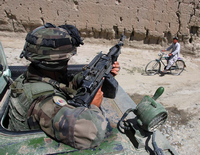The U.S. is determined to implement a counterinsurgency strategy in Afghanistan, and one of the most important concepts of counterinsurgency is securing the people: Insurgents and counterinsurgents alike must appeal to the people they're fighting amongst in order to deny the other popular support.
But what does it mean to "secure the people" of Afghanistan? Some of the U.S. government's best thinkers about defense policy and counterinsurgency, many of whom cut their teeth on the urban battlefields of Iraq, have finally begun to consider this question. But although Iraq is vastly different from Afghanistan, there seems to be no end to "importing" lessons from Baghdad to Kabul: tribal militias, awakenings, and, most worryingly, a focus on cities.
David Kilcullen, a former adviser both to Secretary of State Condoleezza Rice and Gen. David Petraeus, the commander of CENTCOM, said in an interview last year that 80 percent of the population in the southern half of Afghanistan "live in one of two places: Kandahar city, or Lashkar Gah city." More recently Gen. Stanley McChrystal, the commander of U.S. forces in Afghanistan, declared that he will refocus the military's strategy on "the population centers" of the country.

